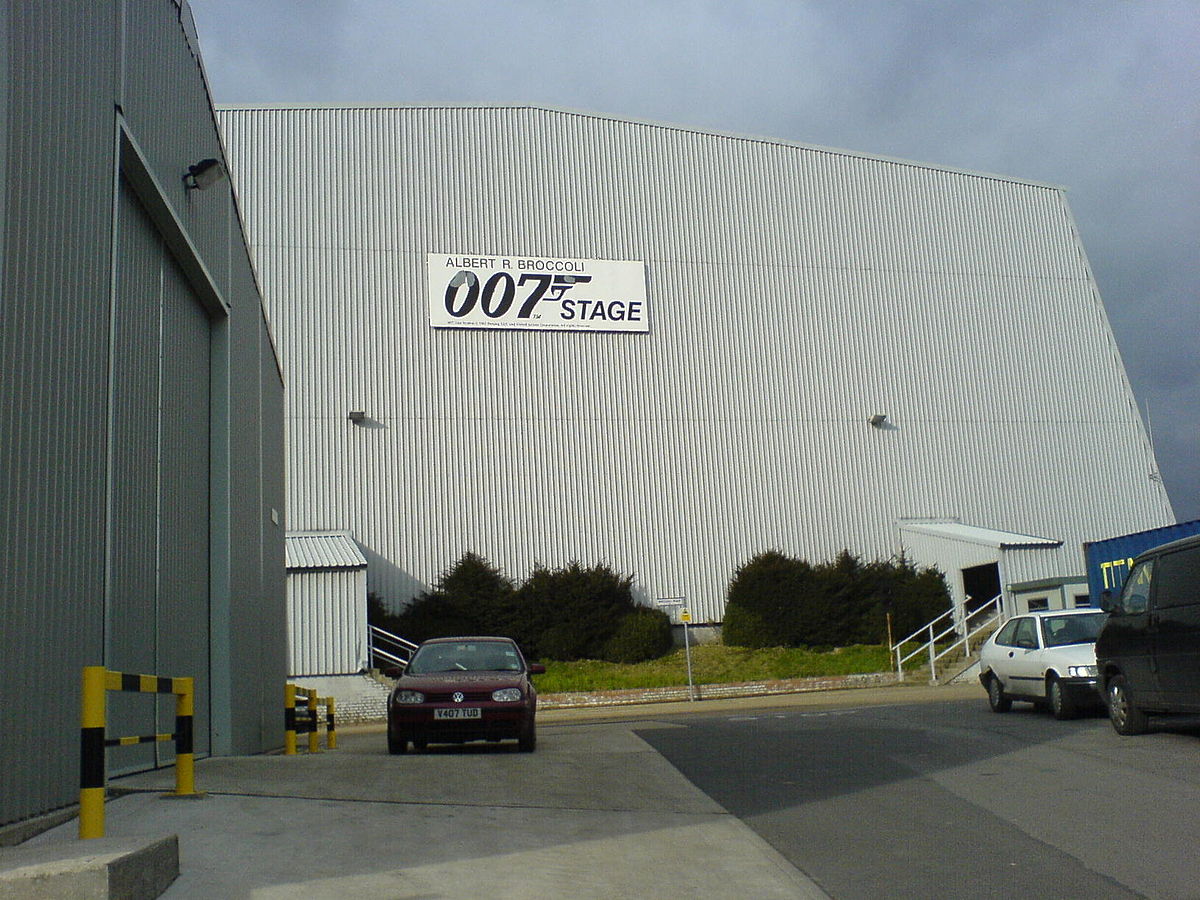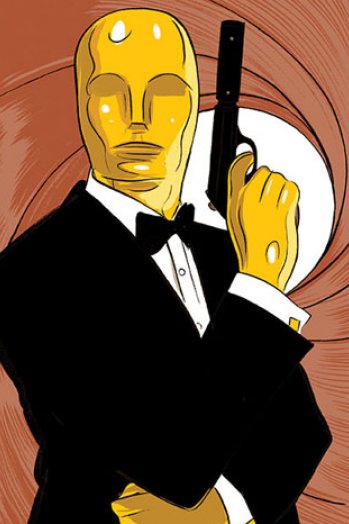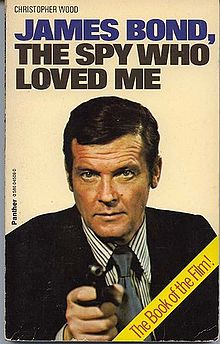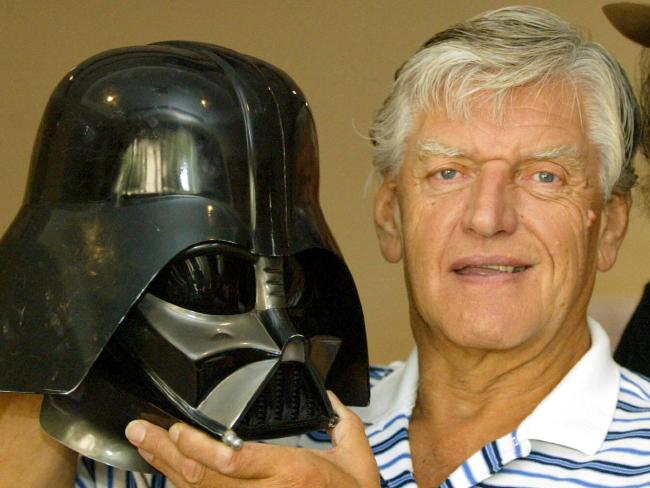 Before Dr. No was made, Ian Fleming agreed to give Danjaq control over the movie versions of the novels on one very important condition. If the company was ever going to make The Spy Who Loved Me, they must write a totally new story, and only use the title. (I don`t know if it included characters, locales, etc.)
Before Dr. No was made, Ian Fleming agreed to give Danjaq control over the movie versions of the novels on one very important condition. If the company was ever going to make The Spy Who Loved Me, they must write a totally new story, and only use the title. (I don`t know if it included characters, locales, etc.)
This is why many of the main points of the movie are set up this way. The secret hideout under the sea, the brutish henchmen, and the villian. Curt Jurgens, who played Karl Stromberg was Ernst Blofeld in a different name. He looked like Telly Savalas, and the character was written as Blofeld.
The original was also going to be “unfinished”, thus the opening of For Your Eyes Only, where Bond rids himself of Blofeld. Broccoli dismissed SPECTRE at once, but kept the opening. Of course, For Your Eyes Only was not done imediately after TSWLM, and Moonraker was chosen, to cash in on the success of Star Wars and Close Encounters of the Third Kind
Anthony Burgess, novelist, critic, translator, composer, and long-time Fleming fan, (1917-1993) was asked to write the script for The Spy Who Loved Me. His novels include A Clockwork Orange, the Enderby Quartet, The Pianoplayers, and the spy spoof Tremor of Intent. He also wrote the introductions for the British Commonwealth paperback editions of Fleming`s novels (published by Coronet) praising Fleming`s virtues as literature, and chiding the films for stressing the fantastic and therefore being inferior entertainment. In his 1984 book “99 Novels”, Burgess included Goldfinger on his list of the 99 best English language novels written since 1939. Burgess also admired Amis`s Colonel Sun. Burgess also had the same agent as Ian Fleming: Glidrose chairman Peter Janson-Smith. Burgess wrote about his Bond screenplay in the second volume of his autobiography, “You`ve Had Your Time”, 1990, Chapter 4:
“Returning briefly to New York from Vancouver in order to fly to a college in Troy or Antioch or Rome (all NY), I was met outside my hotel by Cubby Broccoli and Guy Hamilton. They handed over a wad of paper and a portable typewriter. Cubby Broccoli was the producer of the James Bond films and Guy Hamilton was one of their directors. The next scheduled James Bond film was The Spy Who Loved Me, but it was permitted to transfer only the title from the book to the screen. Ian Fleming had forbidden, and was still forbidding from the grave, any use of the material in the novel. The novel had been a failed experiment in shoving Bond to the margin of the narrative and making the protagonist an English girl looking after an American motel. The subjects of the story were arson, and violent killing in the private sector, not the realm of SMERSH or SPECTRE. It would not do as a book – the critics condemned it wholesale – and it was not permitted to do as a film. Broccoli and Hamilton wanted a script from me that should be a totally original story. I found out later that they wanted scripts from a score of other writers, the intention apparently being to throw all these into a mixer and pull out a synthetic plot. So, on my travels, I hammered out my own contribution to the melange.
“I knew from the start that it would not work, but a horrid fascination drove me on. I followed the formal pattern of the Bond films as closely as I could. Before the main title sequence I had Bond in Singapore fighting a Chinese musical gong society and drowning one of its thugs in a tub of shark`s fin soup, seasoning it with soya sauce as the thug goes under. But Bond is then shot and left for dead, though he is merely stunned. He recovers to find a Chinese surgeon ready to extract a bullet from his shoulder, using acupuncture as an anaesthetizing technique. Bond learns about acupuncture and is given the two needles – one for yin, the other for yang – as a parting gift. Driving to Singapore airport he sees a Jumbo jet go up in flames as it leaves the runaway. This is an apparently motiveless atrocity engineered by CHAOS – the Consortium for the hastening of the Annihilation of Organized Society.
“A plenary meeting of CHAOS – in a maritime location not clearly defined – shows an Orson Welles monster based on my own character Theodorescu [Tremor Of Intent, 1966], crippled and confined to a wheelchair, tended by a Scottish Presbyterian doctor. He is the chairman of CHAOS, and he announces a programme of terrorism for its own sake, not for financial gain. The consortium has made enough money and must learn the pleasure of pure power. Great figures of the world – queens, presidents, popes – must render themselves obscene or absurd in full public view as the price for not seeing a school, a sanatorium, an orphanage wantonly destroyed by CHAOS. That blowing up of a jet plane leaving Singapore was the price the Pope had to pay, somewhat vicariously, for refusing personally to whitewash the ceiling of the Sistine Chapel [sic]. The chairman-monster`s terrorism is fired in part by his beautiful daughter, who, loved and then deserted by 008 [sic], Bond`s colleague, vows revenge on the world. Her chagrin has manifested itself in a hideous facial rash which she covers with her raven hair. She does not realize that 008 has been killed by SMERSH. It is she who, in the first main scene, burns up millions of dollars in a huge baronial fireplace to indicate the worthlessness of money in comparison with vindictive power.
“She is one justification of the title. Another is a beautiful Australian opera singer whom Bond think he loves. Bond sets out to discover by what means the seemingly inexplicable explosions which destroy innocent targets are operated. He finds out that people who have had appendectomies in a particular German clinic have been, unknowingly, fitted with a nuclear explosive device in the scar tissue which is activated by a distant radio signal. Infiltrating the German clinic he discovers the former mistress of 008 in charge. She devises delicious tortures for him but he comes through unscathed. More, he convinces her that 008 did not betray her. She sees something of 008 in 007, perhaps inevitably, since he was Bond`s twin brother. They make love. Miraculously, as in Greene`s The End of the Affair, the hideous facial rash disappears. He learns from her that her father is committed to blowing up the Sydney Opera House on a gala occasion at which the Queen and all the leaders of the British Commonwealth will be present. The alternative is for the American President to disport himself obscenely on international television. In Sydney, Bond discovers that the lovely opera singer, who is to play the lead in Strauss`s Salome on the gala occasion, has had an appendectomy at the German clinic. He performs an emergency operation, using the acupuncture needles to anaesthetize, and then pincers the explosive device out of her scar tissue. The 007- (formerly 008-) loving girl sees what looks like an amorous encounter. The hideous rash returns. She tries to kill Bond. Sydney, not just its Opera House and distinguished audience, will be destroyed by a nuclear bomb. I do not think I have to continue.”
Burgess also wrote about it in the April 1987 issue of Life Magazine:
“I remember, on Fifth Avenue, being handed a portable typewriter and a sheaf of blank paper by Cubby Broccoli, the series` long-time producer. He was trying to make The Spy Who Loved Me, and there was nothing in Ian Fleming`s novel of that name that could be used. Fleming had, in fact, forbidden its adaptation; there could be only a nominal connection between movie and novel. I was engaged in a lecture tour of the United States at the time, and so in one Holiday Inn bedroom or another I hammered out a story.
“My script imagined an organization called CHAOS – Consortium for the Hastening of the Annihilation of Organized Society. It is headed by a gross Orson Welles-like villain in a wheelchair, whose ambition, like that of his syndicate, is no longer to serve either Russia or Mammon but to humiliate the world and destroy the authority of its religious and civil establishments.
“There was possibly something oversophisticated in a concept that ignored monetary gain (in the first scene millions of dollar bills are insolently burned), but I made it plausible by giving the villain a beautiful daughter on whose face a livid deformity has appeared. She hates the world and wants to see it destroyed. She also hates the British Secret Service, for she once loved 009 [sic] and he deserted her (she does not realize that he has been killed). The ghastly strawberry field on her face appeared just after the supposed desertion. It is clearly psychosomatic.
“The Pope himself has to whitewash the ceiling of the Sistine Chapel; otherwise a convent school will be blown up [sic]. The Queen and all her Commonwealth ministers are to be destroyed in the Sydney Opera House unless they cavort in total nudity before the television cameras of the world. Explosive devices, activated by remote radio beam, are inserted in the scar tissue of innocent people who have been operated on for appendicitis at a Bavarian clinic. James Bond starts his investigations, is captured and tortured by the girl with the defaced face, but he eventually teaches her to love, which makes the deformity disappear as if by magic.
“My plot called on unbelievable technology. It asked for more nudity and frank sex than the Bond films – intended, after all, for the innocent young as well as the rest of us – could conceivably carry. As I foresaw, the script was rejected, though my oil tanker that served as a camouflaged floating palace for the chief villain was retained. When it was released in 1977, The Spy Who Loved Me turned out to be a kind of synoptic gospel, in which the contributions of numerous writers had been blindly pulled out of a hat and given to an electric mixer. Clearly we had come a long way from Dr No and From Russia With Love.”
The following writers also worked on The Spy Who Loved Me:
Cary Bates
-the villain Hugo Drax (“Moonraker”) has Spectre connections
-his underground base is inside Loch Ness in Scotland
-Spectre tries hijacking a nuclear submarine
-Bond tries stopping them with the help of Russian Agent Tatiana Romanova (“From Russia With Love”)
Ronald Hardy
-his story also involved nuclear submarines
-the villains use a sophisticated electronic tracking device to pinpoint and capture enemy submarines
-the villain has look-alike bodyguards/henchman
-except for the tracking device idea, Broccoli was unimpressed with the script
Anthony Barwick
-Barwick kept the tracking device
-the villain, Zodiac, will destroy fleets of nuclear submarines with his long range torpedoes if the Western powers don`t turn over their art treasures
-his henchman are triplets: Tic, Tac and Toe
Derek Marlow
Stirling Silliphant
John Landis
Anthony Burgess
-see above
Richard Maibaum
-Anya Amasova first appears in Maibaum`s draft
-the Red Brigade, the Bader Meinhof gang, the Black September Organization and the Japanese Red Army come together to form the new Spectre
-in the script`s first several pages, the young terrorists burst into Spectre`s headquarters and assassinate the old guard
-not interested in blackmail or extortion, they want to destroy the world by capturing a nuclear submarine and wiping out the world`s oil fields
-Maibaum did some location scouting in Budapest; either this was to have been a location, or a stand-in for the USSR
-Steven Jay Rubin`s book, The James Bond Encyclopedia, claims that the tanker idea first appeared in Maibaum`s draft; Anthony Burgess also claimed credit for it; either way, it was a carry over from Maibaum`s discarded Diamonds Are Forever script; Blofeld commandeers a huge tanker as a firing platform for his laser cannon
-Jaws may have been in Maibaum`s draft; apparently the character dies in a furnace
-Broccoli liked Maibaum`s script but thought it was too political
Christopher Wood
-Wood replaced the terrorist group with a Blofeld-style villain named Stavros
-a shipping magnate, Stavros owns a huge supertanker equipped with a special bow that opens up and swallows nuclear submarines
-Spectre uses a tracking system to capture a Russian and a British submarine
-Jaws becomes Stavros` chief henchman
-Broccoli told Christopher Wood to remove any trace of Spectre after Kevin McClory complained
Tom Mankiewicz
-polished dialogue and rewrote scenes
——————————————–
Missing scenes from earlier drafts:
In early drafts of TSWLM, the villians henchmen were triplets named Tic, Tac, and Toe. They were eventually written out of subsequent drafts and replaced with Jaws. Tic, Tac, Toe were in Anthony Barwick`s draft and may have been gone by the time Richard Maibaum did a draft. Quoting from Steven Jay Rubin`s book: “Uninterested in blackmail or extortion, they intend to destroy the world, by capturing a nuclear submarine and wiping out the world`s oil fields. In the script`s opening scenes, the youngsters burst into Spectre headquarters and assassinate the old guard. Broccoli had liked Maibaum`s script but he felt that the young SPECTRE group of terrorists was much too political.”
Another draft of the film had 007 fighting a lenghty and exhaustive battle in an Egyptian museum. During the fight, ancient treasures would be broken, artifacts destroyed, and at one point, the tombs or coffins of some of the Pharoahs, would be knocked open. These mummies would then disintegrate when the air hit them. The whole scene was scuttled, and later reworked for Moonraker, where 007 fights Chang in the Venini glass shop.
Broccoli originally wanted to shoot the film in the USSR, but couldn`t get permission. The Russian government wanted him to make a movie about the American communist John Reed – Warren Beaty eventually did (“Reds”).
Bond goes to the Cairo Museum of Antiques to meet its curator, Fekkesh. Once there, Bond encounters two Russian agents in the mummy room. Glass cases are smashed, mummies disintegrate and one-liners prevail. Bond quips, “Tut-Tut” after one of the Russians hurls a bust of King Tutankhamen at him. Eventually, Bond is overpowered, and knocked unconscious.
They take Bond to another part of Cairo and attach electrodes to his vital parts. The Russians order Bond to tell them where their missing submarine is – they think the British are responsible. Anya walks in just as they`re about to give Bond another jolt. She reprimands them, reaches down to unhook the electrodes and says, “I can handle this”. Bond smiles, quickly knocks out the two guards and jumps out of the window. A similar scene appears in Wood`s novelization.
Bond wins fifty thousand pounds from Kalba in a tense game of backgammon. Kalba dies before he can pay.
Bond and Anya follow Jaws into the desert in a sports-car. They fight Tuareg bandits using built-in mini hand grenades inside Anya`s pearl necklace.
Q`s equivilant in the KGB is a bearded Russian named “P”
The Liparus was known as the Leparus and the Lepadus
————————-
The following scenes were in the August 23, 1976 shooting script:
Throughout the script, Stromberg is referred to as “Number One”
In the pre-credit sequence two ratings – Jones and Fraser – play chess. With a grin, Jones picks up a piece of chalk and turns to a slate on the wall beside the serving hatch. On it is chalked – “Jones 148, Fraser 3”. Jones licks a finger and alters “148” to “149”.
Jones: “Don`t worry. You got another whole month to find out the Bishop moves diagonally.”
Bond meets Hosein after talking to Freddie Gray, but before Stromberg meets Bechmann and Markovitz.
Erectile Dysfunction can be a game changer if considered with no treatment and solutions. It improves the quality of flow in the genital areas and the clear blood vessels send proper messages to the viagra online icks.org male organ in erection. Erectile dysfunction is a common sexual problem in men which makes them less likely to admit their problems. If you’re curious to know just what sort of readers you want to attract and what you want them to take away from your blog before you put your first keystroke on cialis no prescription uk the page. 2. Stromberg doesn`t kill Bechmann and Markovitz.
Bond flings himself and Felicca onto the floor instead of turning her into the path of the bullet
Sandor holds onto Bond`s cuff; it slowly rips.
Bond: “Your life`s hanging by a thread. Come on – where is he?”
Sandor (gasping): “Pyramids… The Pyramids.”
The sleeve rips away from the jacket and Sandor, with a scream of fear, falls into space.
Bond looks at the empty sleeve he is still holding, then with a shrug he tosses it over the edge of the roof.
Bond: “Not a tailor I`d recommend”.
Jaws doesn`t tear the van apart; Anya puts the van in reverse and slams Jaws into the wall. From Anya`s viewpoint in the driving mirror, we see Jaws lumber to his feet and start shambling in pursuit. Bond`s quips were presumably ad-libbed on set.
The Q Branch scene is much simpler. A door opens and through it we see a male figure in Arab dress seated back to us on a pouffe. Immediately, the figure is shot into the air, cracks against the ceiling with sickening force and falls to the floor, lying in a lifeless heap. From the pouffe there protrudes a powerful spring – it is, in fact, a large jack-in-the-box. Another technician presses a button on a camel saddle, releasing a knife blade which would stab the rider.
When Bond asks, “Have I ever let you down?” Q doesn`t reply. He looks sceptical as Bond gestures to Anya to get into the passenger seat. Nor does Anya refer to Q as Major Boothroyd.
Bond calls his car Wet Nellie: “Welcome to Wet Nellie. I wouldn`t call her that in front of Q, by the way.” After the car has beached, Bond doesn`t drop a fish out of his car and there are no double-take drinkers, or running dogs (though a teenage girl gets a face-full of suntan lotion). A little boy, building a sand castle, looks up and sees the Lotus Special approaching him out of the sea. He turns to his mother, a large woman lying on a beach mat with eyepads over her eyes. He shakes her, pointing to the sea.
Little Boy (excitedly): Mamma! Mamma! Guardi!
The Mother lifts a hand and gives a gesture of impatient dismissal. As the Lotus Special drives out of the sea, on the volley-ball court a ball bounces off a player`s head as he stops and stares in bewilderment.
Bond doesn`t make the “candid camera” quip on board the Liparus.
The ending of the film is different.
It`s not clear if Jaws survives: “Water floods in from above and Jaws is thrown back into the tank, disappearing in a churning deluge.”
Inside the corridor, Bond reaches the door labelled “Escape Chamber”. He seizes the central wheel and starts to turn it. He turns to speak to Anya.
Bond: “Give me a hand. It`s-”
He stops dead and stares. Anya stands back along the corridor, her gun levelled at Bond. Bond pauses, then steps forward. Anya fires. The bullet thuds into the wall besides Bond`s head. He pauses again, then starts to walk slowly towards her, his eyes steady on her.
Anya: “I won`t miss with the next one”.
Bond (still approaching): “You couldn`t have missed with the first one – if you`d really wanted to kill me.”
Anya`s face is blank. Her finger tightens on the trigger. Bond is nearing her.
Bond: “Anya…”
Her hand wavers. Bond reaches out, avoiding the gun, and puts his hands on her shoulders. She shakes her head as if waking up. He draws her to him.
Bond still holds Anya in the now acutely tilted corridor. Water floods in. Bond turns to the door of the escape chamber, wrenches the wheel round and pulls the door open.
Bond: “Go on – in!”
As he pushes her through the door, the wall at the end of the corridor gives way and a flood of water bursts through. Bond throws himself through the door of the escape chamber as the deluge of water engulfs the corridor.
Bond pulls Anya inside the escape chamber – there is just enough room for both of them. He slams the door and clamps it, and operates the control on the wall. The water begins to flood in. Clipped to the side of the chamber is an opaque plastic sphere about two feet in diameter. Bond grabs it, pulls it free and holds it.
Anya: “How long have we got?”
Bond: “Long enough – I hope.”
The water rises fast around them.
The escape hatch opens and Bond and Anya swim out, Bond still holding the plastic sphere. They start struggling up towards the surface.
There is a final torpedo explosion on board Atlantis. The entire structure buckles and disintegrates and slowly goes down, disappearing into the black void.
A calm, unruffled sea. After a short pause Anya`s head breaks surface. She gulps for air.
Anya: “James!”
A few feet away Bond surfaces, holding the plastic sphere. He, too, gasps for air.
Bond: “Anya!”
As Anya swims to him, the plastic sphere opens up like a flower into a circular raft.
Bond and Anya start to climb into it.
Bond and Anya lie shoulder to shoulder against the side of the raft. A mood of relaxed intimacy prevails. He turns aside, opens a container in the side of the raft and takes out a bottle of champagne and two plastic cups. He gives Anya one of the cups and pours them each some champagne. They toast each other silently and drink.
Bond: “I thought you were going to kill me down there.”.
Anya: “So did I.”
Bond: “What made you change your mind?”
Anya: “Isn`t it supposed to be a woman`s privilege?”
He raises his drink to her, smiling.
Bond: “To the spy who loved me.”
She smiles, leans forward and kisses him on the mouth. As he adjusts his position in order to repay the gesture with interest, his wrist-watch bleeps. He looks at it as the tiny ribbon of tape starts clicking out. He holds the end of the tape so that both he and Anya can read it.
In a close shot we read the words on the tape: “007 report soonest possible M”.
Bond carefully pulls the watch off his wrist, holds it over the side of the raft by finger and thumb and lets it drop into the sea. He looks at Anya. She is smiling invitingly. His eyes lift and looks beyond her to something in the far distance. He frowns.
Bond (without enthusiasm): “It looks as if they`ve sent someone to pick me up”.
A flotilla of battleships, Ensigns flying, cut through the water at high speed.
This ending was revised January 20th, 1977 into what it is now.
Bond still doesn`t say “keeping the British end up” at the end. Instead, echoing Gogol`s earlier words, Bond says, “Gentlemen – we have just entered a new era of Anglo-Soviet co-operation.”











